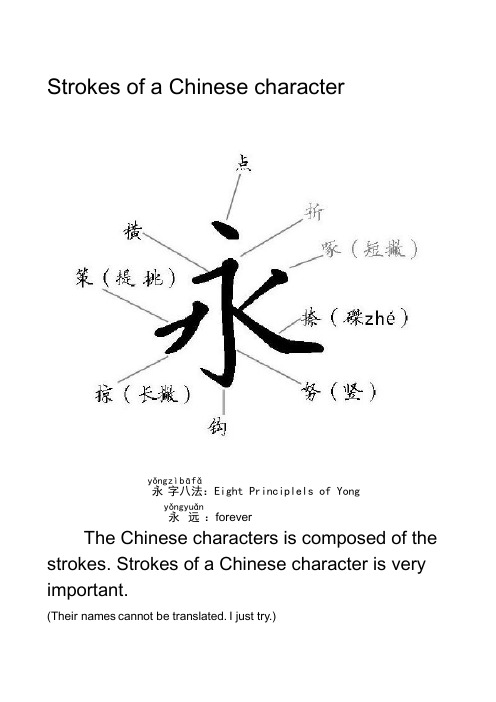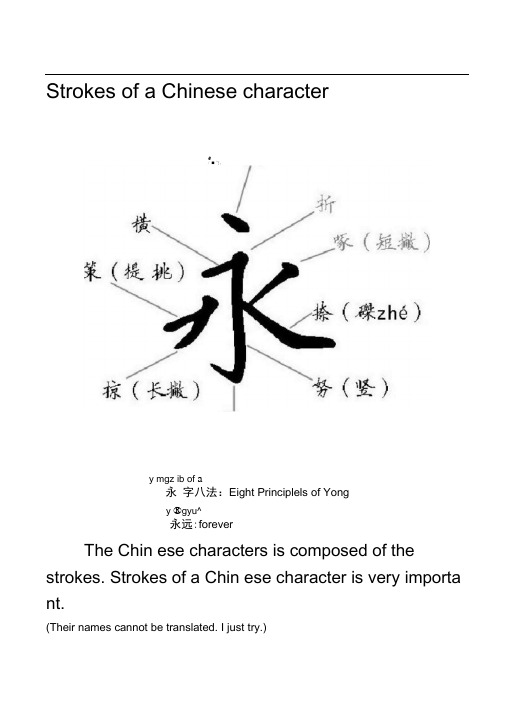汉字笔画英文翻译讲课教案
- 格式:doc
- 大小:752.50 KB
- 文档页数:5

Strokes of a Chinese character永y ǒng 字z ì八b ā法f ǎ:Eight Principlels of Yong永y ǒng 远yu ǎn :foreverThe Chinese characters is composed of the strokes. Strokes of a Chinese character is very important.(Their names cannot be translated. I just try.)精选文档 点di ǎn ——dot , 即j ítiny dash 。
横h éng——horizontal ,即rightward stroke 。
竖sh ù——vertical ,即downward stroke 。
撇pi ě——throw away OR left-falling ,即falling leftwards ,withslight curve ,not very curved 。
捺n à——press down OR right-falling ,即falling rightwards, flattening at the bottom 。
提t í——rise OR rising ,即flick up and rightwards ,taper 。
撇点pi ědi ǎn ——throw away - dot竖提sh ùt í——vertical – rise折——break OR turning ,即90 degree turn ,going down or going right only 。
横折提h éngzh ét í——horizontal- break- rise 弯w ān——bend ,即usually concave on the left 。

Objective:To introduce students to the art of English calligraphy, focusing on the basics of penmanship, tools, and techniques. By the end of the lesson, students will be able to write in a simple English calligraphy style and understand the importance of proper posture and hand movement.Duration:1 hourMaterials:- Calligraphy pens (fine-pointed nibs)- Ink pots- Writing paper (preferably calligraphy paper)- Pencil and eraser- Ruler- Calligraphy guides or templates- eraser- Waste paper for practiceLesson Outline:1. Introduction (5 minutes)- Briefly introduce the concept of calligraphy and its significance in various cultures.- Explain that English calligraphy, while less traditional than its European counterparts, is still a valuable skill.- Highlight the benefits of learning calligraphy, such as improved hand-eye coordination, better writing skills, and the aesthetic pleasure of creating beautiful scripts.2. Tools and Materials (10 minutes)- Show and explain the different types of calligraphy pens available, such as the dip pen, brush pen, and fountain pen.- Discuss the importance of ink quality and how to choose the right ink for different pens.- Introduce the types of paper suitable for calligraphy and demonstrate how to hold the paper correctly.3. Basic Posture and Hand Movement (10 minutes)- Teach students the correct posture for calligraphy, emphasizing the importance of a relaxed body and a stable chair.- Demonstrate proper hand and wrist movement to ensure smooth and controlled strokes.- Encourage students to practice these movements with a pencil before moving on to penmanship.4. Basic Strokes and Characters (20 minutes)- Introduce the basic strokes of English calligraphy, such as upstrokes, downstrokes, and loops.- Use calligraphy guides or templates to demonstrate how to form simple letters and words.- Have students practice these strokes on waste paper, ensuring they maintain the correct posture and movement.5. Writing a Sentence (15 minutes)- Choose a short sentence or phrase that is easy to write and visually appealing.- Demonstrate how to write the sentence in a calligraphy style, emphasizing the flow and rhythm of the letters.- Encourage students to copy the sentence, providing individual guidance and feedback as needed.6. Reflection and Practice (10 minutes)- Have students reflect on what they have learned and discuss the challenges they faced.- Provide opportunities for students to practice their calligraphy further, either by writing another sentence or by creating their own design.- Remind students to keep practicing regularly to improve their skills.7. Conclusion (5 minutes)- Summarize the key points of the lesson, emphasizing the importance of practice and patience.- Encourage students to continue exploring the art of English calligraphy and to share their newfound skills with others.Assessment:- Observe students' participation and engagement throughout the lesson.- Evaluate the quality of their calligraphy work, focusing on theclarity of strokes, letter formation, and overall aesthetic appeal.- Provide constructive feedback and suggestions for improvement.Homework:- Assign students to practice their calligraphy at home, using a sentence or phrase of their choice.- Encourage them to experiment with different calligraphy styles and to document their progress.。

书法教学教案模板英语初中课程名称:英语书法课课时安排:2课时教学目标:1. 学生能够正确书写26个英文字母的大小写。
2. 学生能够区分字母与拼音的写法,区分字母手写体与印刷体。
3. 学生能够在四线格内正确书写英文字母,主要字母占格。
4. 学生能够规范书写单词和句子,掌握单词和句子的斜度、间距和整体效果。
5. 学生能够养成规范书写的习惯,做到不连笔、少涂抹并学以致用到学习生活中。
教学重点:1. 26个英文字母的规范书写,包括笔顺、优美程度以及占格。
2. 单词和句子的规范书写,从词间距到句间距的扎实掌握与书写。
教学难点:1. 字母f、j、a、q、d、p、o、y的书写。
2. 单词和句子的规范书写,从词间距到句间距的扎实掌握与书写。
教学工具:1. 教学课件或黑板2. 英文字母书写模板3. 四线格纸张4. 书写示范作品教学方法:1. 教师演示法:通过教师的演示来加强学生积极性,展示规范书写的步骤和方法。
2. 比较法:将好的作品与相对较差的作品进行比较,帮助学生在比较中加深掌握程度。
3. 实践练习法:学生通过实际书写练习,提高书写技巧和熟练度。
教学过程:一、导入(5分钟)1. 教师带领学生唱字母歌,引起学生对英语字母的兴趣。
2. 展示一些书法作品,引导学生关注书法的美感。
二、教学内容与实践(20分钟)1. 教师讲解并示范26个英文字母的大小写书写顺序、占格和笔顺。
2. 学生跟随教师一起书写,注意字母f、j、a、q、d、p、o、y的书写。
3. 学生独立书写字母,教师巡回指导。
三、练习与展示(10分钟)1. 学生用四线格纸张书写英文字母,注意字间距和整体效果。
2. 学生展示自己的作品,教师给予评价和指导。
第二课时:一、复习与导入(5分钟)1. 复习上节课所学的英文字母书写知识。
2. 教师展示一些优秀的书法作品,引导学生进一步关注书法的美感。
二、教学内容与实践(20分钟)1. 教师讲解并示范单词和句子的规范书写方法,包括斜度、间距和整体效果。

Strokes of a Chinese character占/ ■ "!、y mgz ib of a永字八法:Eight Principlels of Yongy ®gyu^永远:foreverThe Chin ese characters is composed of the strokes. Strokes of a Chin ese character is very importa nt.(Their names cannot be translated. I just try.)折 --- break ORturning ,即 90 degree turn , going downor going right only 。
h engzh & i 横折提 ---- horiz on tal- break- risewoi弯 --- b en d , 即 卩 usually con cave on the leftsh iwaig cu竖弯钩 ---- vertical- bend- hookxi e斜 --- s la nt ,即 usually con cave on the right1即tinydi d n 点 ----dot , h e g横 ---- horizontal ,即 rightward stroke 。
sh u竖 --- vertical ,即 downward stroke 。
throw away OR left-falli ng,即 falling leftwards , withslight curve , not very curved 。
n a 捺 -- press dow n OR right-falli,即 falling rightwards,flattening at the bottomt i 提 -- rise OR rising ,即 flick up and rightwards , taper 。

识字的英语启蒙教案初中课时:2课时年级:初中教学目标:1. 学生能够认知并正确书写26个英文字母。
2. 学生能够理解并运用一些基本的英语单词和简单句子进行日常交流。
3. 学生能够培养对英语学习的兴趣和热情。
教学内容:1. 26个英文字母的认知和书写。
2. 一些基本的英语单词和简单句子的学习。
教学过程:第一课时:一、热身活动(5分钟)1. 教师与学生用中文进行简单的自我介绍,例如:“你好,我叫张三,我今年12岁,我来自中国。
”2. 学生模仿教师,用中文进行自我介绍。
二、引入英语学习(10分钟)1. 教师向学生介绍:“我们今天开始学习英语,你们将会认识26个英文字母,就像你们认识的汉字一样。
”2. 教师展示26个英文字母的卡片,一边展示一边发音,让学生跟随一起发音。
三、学习26个英文字母(15分钟)1. 教师将学生分成小组,每组学生轮流发音并书写26个英文字母。
2. 教师在黑板上书写26个英文字母,并让学生跟随书写。
四、学习基本单词和句子(20分钟)1. 教师向学生介绍一些基本单词,如:“你好”(hello),“再见”(goodbye),“谢谢”(thank you),“对不起”(sorry)。
2. 教师让学生跟随一起发音并书写这些单词。
3. 教师引导学生用这些单词组成简单的句子,如:“你好,我叫李四。
”(Hello, my name is Li Si.)第二课时:一、复习上节课的内容(5分钟)1. 教师引导学生复习26个英文字母的书写和发音。
2. 教师让学生用基本单词和句子进行自我介绍。
二、深入学习基本单词和句子(15分钟)1. 教师向学生介绍一些常用的疑问词,如:“你是谁?”(Who are you?),“你叫什么名字?”(What's your name?),“你多大了?”(How old are you?)2. 教师让学生跟随一起发音并书写这些疑问词。
3. 教师引导学生用这些疑问词组成简单的句子,并进行问答练习。

一、课程基本信息课程名称:笔译基础课程性质:专业基础课授课对象:翻译专业本科生授课时间:16周,每周2学时授课地点:教室编号二、教学目标1. 知识目标:- 理解和掌握笔译的基本理论和方法。
- 掌握常见的翻译技巧和策略。
- 了解不同类型文本的翻译特点。
2. 能力目标:- 提高学生的汉英或英汉笔译能力。
- 培养学生的翻译思维和跨文化交际能力。
- 增强学生的自主学习能力和批判性思维能力。
3. 素质目标:- 培养学生的职业道德和职业素养。
- 增强学生的团队协作能力和沟通能力。
三、教学内容第一周:课程介绍与翻译理论概述- 课程目标与要求- 翻译的定义与类型- 翻译的标准与原则第二周:翻译技巧与方法- 直译与意译- 直译与转译- 词语的选择与处理第三周:句子结构与翻译- 句子成分的翻译- 句子结构的调整- 句子层面的翻译技巧第四周:段落与篇章翻译- 段落翻译的步骤- 篇章翻译的技巧- 翻译中的逻辑与连贯第五周:特定文本类型翻译 - 科技文本翻译- 法律文本翻译- 文学文本翻译第六周:翻译批评与评估- 翻译批评的标准- 翻译评估的方法- 翻译中的常见错误第七周:翻译实践与案例分析 - 翻译实践作业- 案例分析讨论- 翻译实践的反馈与改进第八周:翻译技术工具与资源- 翻译软件的使用- 翻译数据库的利用- 翻译资源的获取第九周:跨文化交际与翻译- 跨文化交际的基本原则- 翻译中的文化差异处理- 跨文化翻译案例分析第十周:笔译职业发展与市场分析- 笔译职业介绍- 翻译市场需求分析- 职业规划与求职技巧第十一周至第十四周:翻译实践与模拟考试 - 翻译实践作业- 模拟考试与评估- 作业反馈与指导第十五周:课程总结与反思- 课程内容回顾- 学生翻译作品展示- 教学效果评估与反馈第十六周:结业考试- 翻译能力测试- 考试结果分析与总结四、教学方法1. 讲授法:系统讲解翻译理论、技巧和方法。
2. 案例分析法:通过具体案例讲解翻译实践。
Objective:To introduce students to the art of English calligraphy, focusing on the basics of pen hold, stroke formation, and the use of different nibs. By the end of the lesson, students will be able to write a simple sentence in an elegant calligraphic style.Duration:1 hourMaterials:- English calligraphy sets (including nibs, inks, and nib holders)- Calligraphy paper- Rulers- Pencils- Erasers- Blackboard or whiteboard- MarkersLesson Outline:I. Introduction (10 minutes)1. Warm-up: Begin with a brief discussion about the importance of handwriting in the digital age. Ask students to share their experiences with writing by hand.2. Introduction to Calligraphy: Explain what English calligraphy is and its significance in the history of writing. Discuss how it differs from regular handwriting.3. Goals of the Lesson: Outline the objectives of the lesson, emphasizing the focus on pen hold, stroke formation, and the use of different nibs.II. Basic Pen Hold and Strokes (15 minutes)1. Demonstration: Show students how to properly hold the pen. Emphasize the importance of a relaxed grip and the position of the hand and arm.2. Stroke Formation: Demonstrate the basic strokes used in English calligraphy, such as the downstroke, upstroke, loop, and curve. Use the blackboard or whiteboard to illustrate these strokes.3. Practice: Instruct students to practice these strokes on their calligraphy paper, ensuring proper form and consistency.III. Nib Selection and Ink Application (10 minutes)1. Nib Selection: Introduce different types of nibs (e.g., round, italic, pointed) and their respective uses. Explain how the choice of nibaffects the style of calligraphy.2. Ink Application: Demonstrate how to load the nib with ink properlyand how to maintain ink levels throughout the writing process.3. Practice: Allow students to experiment with different nibs and inks, encouraging them to find the combination that suits their style.IV. Writing a Simple Sentence (15 minutes)1. Selection of a Sentence: Choose a simple sentence for students to practice, such as "Hello, my name is [Your Name]."2. Guided Writing: Instruct students to write the sentence in an elegant calligraphic style, paying attention to spacing, letter formation, and the overall aesthetic.3. Feedback: Provide individual feedback to students on their writing, focusing on areas of improvement and celebrating their achievements.V. Conclusion (10 minutes)1. Reflection: Ask students to reflect on what they learned during the lesson and how they can incorporate calligraphy into their daily lives.2. Closing Activity: Encourage students to create their own calligraphic designs or practice writing additional sentences.3. Homework Assignment: Assign a homework task, such as practicing a new calligraphic style or creating a calligraphic poster with a chosen theme.Assessment:- Observe students' participation and engagement during the lesson.- Evaluate the quality of their pen hold, stroke formation, and overall calligraphic style.- Assess their ability to follow instructions and complete the assigned tasks.Additional Notes:- Ensure that students have access to a variety of nibs and inks to explore different styles.- Provide students with a checklist or rubric to guide their practice and self-assessment.- Offer additional resources, such as online tutorials or calligraphy books, for students interested in further learning.。
课时:2课时年级:七年级教学目标:1. 让学生掌握正确的英语书法执笔方法。
2. 使学生能够正确书写26个英文字母的大小写。
3. 培养学生观察和评价自己书法作品的能力。
4. 提高学生的审美情趣,激发学生对英语书法的兴趣。
教学重点:1. 英文字母的正确书写顺序。
2. 英文字母的大小写书写规范。
3. 书法作品的整体布局和美观度。
教学难点:1. 各个字母的高度、宽度、斜度和格位的把握。
2. 书法作品的整体布局和美观度的提升。
教学准备:1. PPT课件2. 直尺3. 练习本4. 纸笔教学过程:第一课时一、导入1. 播放一段优美的英文书法作品视频,激发学生的兴趣。
2. 引导学生思考:英语书法与中文书法有何异同?二、基本笔画与执笔方法1. 介绍26个英文字母的基本笔画。
2. 讲解正确的执笔方法,强调笔尖与纸面的角度。
3. 通过PPT展示正确的执笔图示,让学生跟随练习。
三、字母书写规范1. 引导学生观察PPT上的字母书写规范图示。
2. 讲解字母的大小写书写顺序,重点讲解易混淆的字母。
3. 让学生跟随教师示范,练习字母书写。
四、书法作品布局与美观度1. 介绍书法作品的整体布局,包括行距、字距等。
2. 讲解如何提高书法作品的美观度,如笔画的粗细、墨色的深浅等。
3. 让学生尝试在四线格内书写字母,注意整体布局。
五、课堂小结1. 对本节课所学内容进行总结,强调重点和难点。
2. 布置课后作业,让学生回家练习字母书写。
第二课时一、复习导入1. 复习上节课所学内容,检查学生的掌握情况。
2. 引导学生分享自己的书法练习心得。
二、拓展练习1. 让学生尝试书写单词和句子,注意字母间的间距和整体布局。
2. 教师挑选优秀作品进行展示,让学生学习借鉴。
三、书法作品评价1. 引导学生观察优秀书法作品,学习其优点。
2. 让学生互相评价书法作品,提高自己的审美能力。
四、课堂小结1. 对本节课所学内容进行总结,强调书法作品的整体美观度。
2. 布置课后作业,让学生回家练习书写单词和句子。
Strokes of a Chinese character永y ǒng 字z ì八b ā法f ǎ:Eight Principlels of YongThe Chinese characters is composed of the strokes. Strokes of a Chinese character is very important.(Their names cannot be translated. I just try.)点di ǎn ——dot , 即j ítiny dash 。
六横h éng——horizontal ,即rightward stroke 。
大竖sh ù——vertical ,即downward stroke 。
十撇pi ě——throw away OR left-falling ,即falling leftwards ,with slight curve ,not very curved 。
八捺n à——press down OR right-falling ,即falling rightwards, flattening at the bottom 。
八提t í——rise OR rising ,即flick up and rightwards ,taper 。
地撇点pi ědi ǎn ——throw away - dot 女竖提sh ùt í——vertical – rise 比折——break OR turning ,即90 degree turn ,going down or going right only 。
横折提h éngzh ét í——horizontal- break- rise 讲 弯w ān——bend ,即usually concave on the left 。
基础笔译教案初中1. 知识目标(1)使学生了解笔译的基本概念和流程。
(2)培养学生掌握常用的翻译技巧和方法。
(3)让学生了解不同文体的翻译要求。
2. 能力目标(1)提高学生对原文的理解能力。
(2)培养学生准确、流畅地进行笔译的能力。
(3)提升学生根据上下文和文化背景进行意译的能力。
3. 情感目标培养学生对笔译工作的热爱和敬业精神。
二、教学内容1. 笔译基本概念和流程(1)笔译的定义:笔译是指将一种语言的文字转换成另一种语言的文字。
(2)笔译流程:原文理解、词汇转换、句子重构、校对你的。
2. 常用翻译技巧和方法(1)直译:直接将原文中的词汇、句子结构翻译成目标语言。
(2)意译:根据上下文和文化背景,对原文进行意译。
(3)借代:用目标语言中的词汇代替原文中的词汇。
(4)转译:将原文中的某种语法结构转换成目标语言的另一种语法结构。
3. 不同文体的翻译要求(1)文艺作品:注重情感表达,保持原文的风格和韵味。
(2)科技文章:准确表达原文的科学概念和逻辑关系。
(3)政治文件:忠实原文的政治立场和观点。
(4)商务合同:明确表达原文的商业意图和法律条款。
三、教学重点与难点1. 重点:笔译的基本概念、流程、技巧和方法。
2. 难点:不同文体的翻译要求及实际操作。
四、教学过程1. 导入:通过一个简单的笔译实例,引发学生对笔译的兴趣。
2. 讲解:详细讲解笔译的基本概念、流程、技巧和方法。
3. 实践:让学生进行不同文体的笔译练习,教师进行指导。
4. 讨论:学生之间互相交流翻译心得,教师进行总结。
5. 总结:强调笔译的重要性,激发学生的学习热情。
五、教学评价1. 平时练习:检查学生对笔译技巧和方法的掌握程度。
2. 课程作业:评估学生在不同文体翻译中的表现。
3. 期末考试:测试学生对笔译知识的全面掌握。
六、教学资源1. 教材:选用权威、实用的笔译教材。
2. 辅助材料:提供不同文体的笔译实例和参考译文。
3. 网络资源:利用网络资源为学生提供更多的笔译素材和信息。
汉字笔画英文翻译
Strokes of a Chinese character
永y ǒng 字z ì八b ā法f ǎ:Eight Principlels of Yong
永y ǒng 远yu ǎn :forever
The Chinese characters is composed of the
strokes. Strokes of a Chinese character is very important.
(Their names cannot be translated. I just try.)
点di ǎn ——dot , 即j ítiny dash 。
横h éng
——horizontal ,即rightward stroke 。
竖sh ù——vertical ,即downward stroke 。
撇pi ě——throw away OR left-falling ,即falling leftwards ,with
slight curve ,not very curved 。
捺n à——press down OR right-falling ,即falling rightwards, flattening at the bottom 。
提t í——rise OR rising ,即flick up and rightwards ,taper 。
撇点pi ědi ǎn ——throw away - dot
竖提sh ùt í——vertical – rise
折——break OR turning ,即90 degree turn ,going down or going right only 。
横折提h éngzh ét í
——horizontal- break- rise 弯w ān
——bend ,即usually concave on the left 。
钩g ōu ——hook ,即j íappended to other strokes ,going down or going left only 。
弯钩w āng ōu ——bend-hook
竖钩sh ùg ōu ——vertical-hook
竖弯钩sh ùw āng ōu
——vertical- bend- hook 斜xi é——slant ,即usually concave on the right 。
斜钩xi ég ōu ——slant-hook
卧钩w òg ōu ——recline-hook
横钩h éngg ōu ——horizontal-hook
横h éng 折zh é钩g ōu ——horizontal- break -hook
横h éng 折zh é弯w ān 钩g ōu ——horizontal- break- bend-hook
横撇弯钩h éngpi ěw āng ōu ——horizontal- throw away- bend-hook
横折折折钩h éngzh ézh ézh ég ōu ——horizontal- break- break- break-hook 竖折折钩sh ùzh ézh ég ōu ——vertical- break- break-hook
竖弯sh ùw ān ——vertical- bend
横折弯h éngzh éw ān ——horizontal- break- bend
横折h éngzh é——horizontal- break
竖折sh ùzh é——vertical- break
撇折pi ězh é——throw away- break
横h éng 撇pi ě ——horizontal- throw away
横折折撇h éngzh ézh épi ě——horizontal- break- break- throw away 竖sh ù折zh é撇pi ě
——vertical- break- throw away
部b ù首sh ǒu
:radical。